Selma Editor Spencer Averick on the Film’s Toughest Scenes to Cut
Troopers storm into a café. They're looking for the old man, his daughter and his grandson that they'd been chasing after breaking up a night march in Selma. The old man, Cager Lee (played by the phenomenal Henry Sanders), his daughter Viola (Charity Jordan) and his grandson Jimmie Lee Jackson (Keith Stanfield) are trying to hide their faces behind menus at a table in the back. The troopers spot them and throw the 82-year old Cager Lee to the ground, beating him with their batons. Then they turn on Viola and begin to beat her, but Jimmie Lee, her son, attempts to protect her. He's pushed against a cigarette machine by one of the troopers and shot twice in the stomach. He dies. They were all unarmed.
Martin Luther King Jr. (David Oyelowo) visits the morgue to spend time with Cager, both men overwhelmed, the camera staying on their faces, not letting us look away from their pain. Later on in this phenomenal film, there's the madness on the Edmund Pettus Bridge, where the first march from Selma to Montgomery was met as if those unarmed men and women peacefully demonstrating for their right vote were an advancing army. The troopers, in gas masks and riot gear, some on horseback, charge into the fleeing demonstrators intent on inflicting as much pain and horror as possible.
These were just a few of the potent, unspeakably difficult scenes Selma editor Spencer Averick had to cut. He arrived on set in Atlanta on the second day of filming to begin his work. Every day, he would do his best to keep pace with director Ava DuVernay’s incredible pace and assemble the scenes she had filmed the day before into a rough cut, marking those that she preferred and those that had made an immediate emotional impact on him. Once back in Los Angeles, it was another five months of painstaking editing, where Averick and DuVernay poured through each scene looking for the best possible sequence that would put the audience where they needed to be; face to face with the sacrifices these men and women made to see their most fundamental rights granted.
We spoke with Averick about his process, his working relationship with DuVernay, and cutting some of those incredibly harrowing scenes.
So your involvement with Selma actually goes way back, right, to your connection to Ava?
I’ve been with Ava for six years now. I’ve cut every one of her projects. I was there from the beginning, she’d sent me a script well before production. My first impressions were, aside from feeling so lucky to be a part of this story, is that this is a human story. It could have been this epic bio-pic that covers everything from King’s life, skimming over different aspects, but what I loved about it was it was a slice of life, a very human story. This is a universal story about a man, and what he goes through is relatable to every man. I saw that on the page, and Ava and I have an intimate style, so I knew right away once she did the re-writes that we’d inject this intimate style of filmmaking into this story.
Walk me through your process.
I started in the middle of last May. I was there in Atlanta during production for 35 days, then I came back to LA for five months. My routine during production is that I’m in there starting on day two, compiling what Ava and the crew shot on day one. So I come in in the morning and my first assistant editor (Paul E. Alderman) has a strung out of all the takes, roughly two hours worth. So with a coffee in hand, I screen it as if I’m watching a movie.
What are you looking for?
I’m looking for first feelings and impressions. I’m not thinking technically yet. I talk with Ava every night after the shoot, and she’ll tell me if she's concerned about coverage, and about anything else she’s thinking. She'll say something like, ‘I don’t know if I covered this scene, we might need a close-up,’ so I’m her second set of eyes. That’s the most important thing. I’m also cutting. Usually they shoot about three scenes a day, so I start roughing it together. I’m not overthinking anything, I’m just putting it together based on how I feel, using circle takes.
Circle takes?
On set, if Ava likes a take, she’ll tell the script supervisor to tell me she really likes it, to circle it, that’s a circle take. Actors will have a long paragraph of lines or whatever it is in one take, so maybe just a few lines out of that is working, so basically circle takes are little notes from Ava saying, I like this or I like that. I’ll always use those, then I’ll inject my own feelings and opinions on what else I can use.
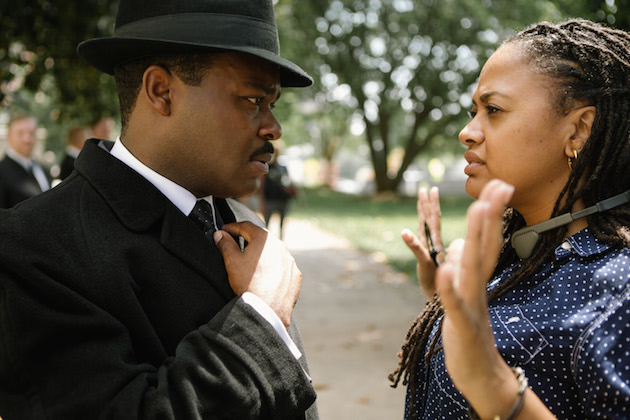
And once production is over, how do you tackle all the scenes you've now strung together?
Then I get back to LA and I have a week or two to continue editing by myself without Ava, to finish the editor’s cut, trying to keep up. When they shoot three scenes in one day, I’m trying to edit three scenes in one day as well, which is hard to do, so you fall behind. So those couple weeks after you get back is your time to catch up. By no means is the editor’s cut great, but the movie’s at least put together, although it’s long and it’s rough. Then Ava comes in after two weeks, she watches the editor’s cut, then we go from there. Then it was five months for the two of us. We had our producers, Plan B, Oprah, and Paramount in dialogue and giving us feedback as well. It’s a collaborative experience, but mainly it’s Ava and I together.
Tell me about this intimate style you and Ava have created.
We like to take our time in a scene. I like to stay on characters faces. It’s all about the face. Ava doesn’t shoot a lot of big establishing shots, we like to stay right in on the character, and follow them on a personal level, whether that means staying tight on their face or not cutting away when it would seem sort of intuitively the right thing to do, you stay on the shot. It’s really an indie way of filmmaking.
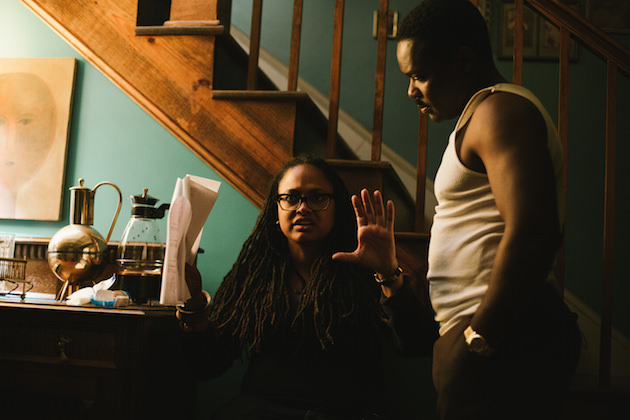
The faces in this film are devastating, whether it’s Cager Lee after his son has been murdered, or Coretta’s when she’s receiving another death threat, so what would a non-indie way of filming those moments be?
The commercial way of editing is really built into you, I’m 36, so when I was a teenager in the 80s and I was watching TV, the MTV style of cutting had become popular, and it’s been injected into mainstream filmmaking. You’re watching something and you think there’s going to be a cut every eight seconds. Then you realize the longer you stay in the shot, the more the audience has to think about what’s happening and ingest what they’re looking at instead of moving onto the next thing.
What sequences did you find most challenging to edit?
One of the scenes I love, which was difficult to cut but I’m happy with the way it turned out, was the scene between Martin and Coretta in their house after the FBI has sent them that tape. So there they are, and somebody on the tape is having sex, and it was basically the government putting Martin on the spot to try and break up the family. That’s an intense scene. And it’s about it Martin and Coretta’s relationship. Just trying to figure out who to be on at what moment and how long to stay on each shot was difficult, but it’s one of my favorite scenes, too. Staying on Martin for an extended period of time and seeing what he’s going through, it was just such an intense family moment, and so I had to cut it very delicately, and it was challenge.
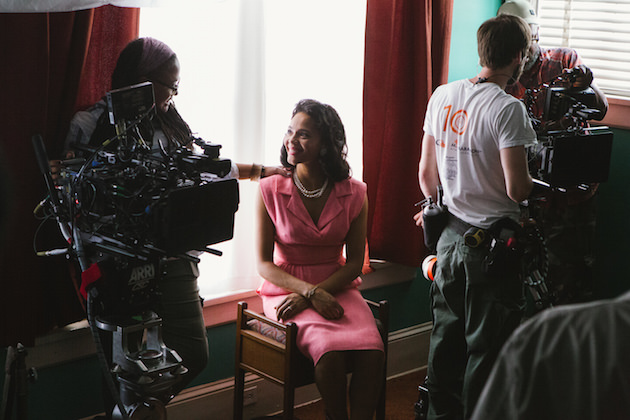
How do you feel your way around a scene like that? Is it trial and error?
Part of it’s intuitive. The first time I cut it, it was more of a traditional back and forth, but then I started to feel like, wait, I don’t want to cut yet, even though I feel like I should, because I want the audience to sit here and look at this man and continue to think about what he’s thinking. So while that first cut was more traditional, I began to hold on the shots a lot longer as I got into the scene. It’s uncomfortable to watch, and you feel for the characters, but I just wanted to really live in that moment and stay on some of these shots longer than you’d think. My intuition as the cut continued to evolve was to stay on shots longer and really make it uncomfortable, a to let the audience think about what was happening and decide for themselves.
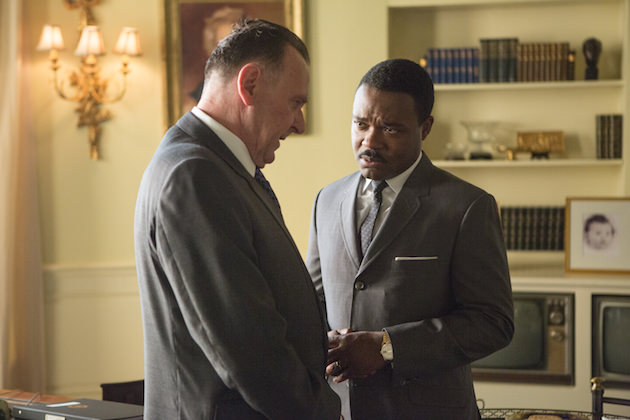
What approach did you take in cutting the scenes when it MLK faces off against LBJ?
Those cuts were definitely quicker, the tempo was a little higher than normal. It was a chess match, it was a lot more back and forth between them. I love those scenes because there’s so much subtext, they get to the point in the scene eventually, but every line is not as it seems, there’s something going on, they’re both trying to push their own agendas, so it’s this political chess match. So my intuition in the cutting room was to tighten the pace, keep it quick, I want to see their reactions, and I want to know at all times what each person is thinking and where they want to go next. They’re listening to each other, but they’re also thinking about what their next move is going to be. So that scene has a lot more reaction shots and a lot of quicker cutting.
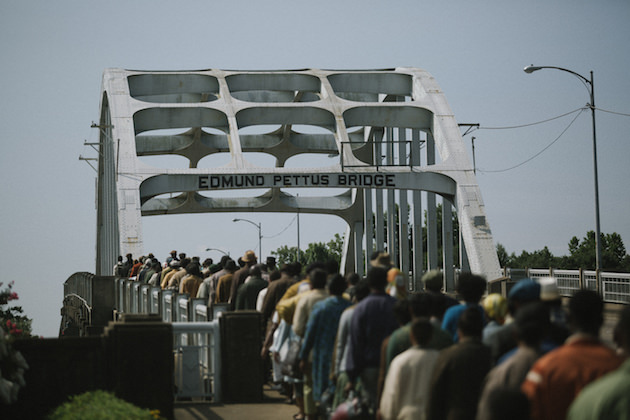
How did you pull together the chaos on the Edmund Pettus Bridge when the troopers attack the marchers?
That was a difficult scene. And Ava could have shot that for two weeks, but she only had two days, and one of those days it was raining. She just did such a great job with the time and resources that she had. As far as the violence on the bridge goes, Ava had three cameras and she just shot a lot. She tried to really give the audience an intimate look into this violence, the expressions on people’s faces, the reactions on their faces as they were getting attacked. In the cutting room, I basically had a lot footage, so it was a matter of picking the moments that hit you emotionally on first watch. I gauged how those particular shots made me feel. A lot of it was very tough to watch and got me on an emotional level, so I picked that stuff out and put it to the side. And then you start piecing it together. It was a long process, we were cutting that scene until the final day.
When did you feel like you got it right?
I’d cut it chronologically first but then we started trying different things, because although it was good, it wasn’t as powerful as we knew it could be. So we started intercutting, which was not in the script originally, intercutting people around the world watching it on TV. Obviously it wasn’t a live broadcast, but in the movie it feels like that, so that was a stylistic choice, to jump back and forth in time and make each violent moment hit home so you’d see a reaction from somebody not there. Once we did that it was easier for me to put the violence on the bridge together because I no longer had to cut it chronologically, I could pick the best moments, hit you with it, then cut to a woman in her living room. Obviously when this really happened, they had to go develop the film and all that, but they still saw it eventually, so all we were doing was jumping back and forth in time.
That scene seems to start off fairly straight forward, with the police charging into the marchers on their horses and in their masks, but then it does begin to feel almost surreally horrifying.
I tried to make it chronological in the beginning. I wanted it to feel real, and I think I have a good thirty seconds of just the chaos, without any music, just chaos, and the feeling of, ‘Oh my god, these policemen are running at us, what do we do?’ Then once they realize they’re being attacked, we get into the stylistic editing choices.
Did you give Ava any script notes at the beginning, anything that you saw as potentially troublesome?
I’m a lucky editor because I have a great director and collaborator and friend in Ava, who cares what I think in the beginning, and this is all I know. Being with her from the beginning all the way through the very end, we do talk about little things with the script and the characters, and we talk about things that might work editorially and that might not. It’s hard to make decisions editorially in the beginning, because the footage dictates so much of the edit.
Featured image: David Oyelowo plays Dr. Martin Luther King, Jr. in SELMA, from Paramount Pictures, Pathé, and Harpo Films.



